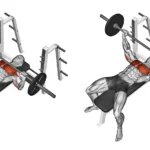Dumbbell Fly: Exercise Overview
The dumbbell fly is a classic isolation exercise designed to target the pectoralis major, emphasizing chest development and definition while secondarily engaging the anterior deltoids. By utilizing a wide, arcing motion, this movement stretches and contracts the chest muscles, making it a staple in bodybuilding for aesthetic purposes. While it can support strength gains in pressing movements like the bench press, the dumbbell fly is primarily used to enhance chest size and shape rather than maximal performance. It’s an ideal addition to chest-focused workouts, upper-body sessions, or bodybuilding-style splits, offering a controlled way to isolate the pecs for lifters of all levels (Schoenfeld, 2010).
How to Perform the Dumbbell Fly
- Select an appropriate pair of dumbbells and sit on a flat bench, resting the dumbbells on your thighs with a neutral grip (palms facing inward).
- Lie back on the bench, keeping the dumbbells close to your chest, then press them upward to the starting position with arms extended and palms facing each other.
- Slightly retract your shoulder blades, maintain a slight bend in your elbows, and lower the dumbbells laterally in a wide arc, stopping when they reach chest level—this is your starting position.
- Squeeze your chest muscles to bring the dumbbells back to the starting position, following the same arc and keeping the elbow angle consistent.
- Pause briefly at the top without letting the dumbbells touch, maintaining tension in the chest, then repeat for the desired number of repetitions.
Tips for Optimal Performance
- Focus on Chest Activation: Visualize hugging a tree to engage the pecs fully, avoiding excessive forearm or bicep recruitment by not gripping the dumbbells too tightly (Schoenfeld, 2016).
- Maintain Elbow Bend: Keep a consistent, slight bend in your elbows throughout the movement to protect the shoulder joints and target the chest effectively (Escamilla et al., 2009).
- Control the Movement: Lower and raise the dumbbells slowly to maximize time under tension and prevent shoulder strain, avoiding excessive stretch at the bottom.
- Keep Shoulders Stable: Slightly retract your shoulder blades and “pack” your shoulder girdle to minimize front shoulder pain and enhance stability (McGill, 2010).
- Breathe Properly: Inhale as you lower the dumbbells and exhale as you bring them together to support core stability and muscle oxygenation (Wirth et al., 2016).
- Avoid Lower Back Arching: Engage your core and keep your feet flat on the floor to prevent excessive lower-back arching, ensuring proper posture.
Sculpting your chest with dumbbell flys? Explore our Ultimate Guide to Muscle Groups to enhance your pectoral training.







